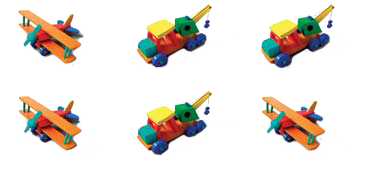B2.1 Use the properties of addition and subtraction, and the relationship between addition and subtraction, to solve problems and check calculations.
Activity 1: How Many Toys?
Present students with six toys and ask them to count them.
Cover the toys with a cloth and tell them that you will add a mystery number of toys.

Pretend to add toys, but do not add anything. Remove the cloth and ask the following questions:
- How many toys are there now?
- How many toys did I add?
Ask students to write a number sentence to represent the situation.
\(\ 6 + 0\)
Repeat the activity, adding 6 toys to 0 toys to represent 0 + 6.
Point out that since 6 + 0 = 6 and 0 + 6 = 6, we can conclude that 6 + 0 = 0 + 6 = 6 and make the connection with the commutative property of addition.
Encourage students to propose a conjecture about the identity rule in an addition, then ask questions such as:
- Could you apply your conjecture to other numbers? Try it out.
- Could you apply your conjecture to all numbers? Why?
Source: translated from Guide d’enseignement efficace des mathématiques de la 1re à la 3e année, Modélisation et algèbre, Fascicule 2, Situations d'égalité, p. 94.
Note: This activity can be modified by changing the initial number of toys.
Activity 2: Trios
Strategy
Commutative Property (Addition or Multiplication)
Materials
- a set of Trio Cards for Addition (Appendix FR15 and Appendix FR16)
This activity is done with the whole class. Each student receives a card from the Trio Cards for Addition game. Once the cards are dealt, students look for the other members of their trio. They need to know the answer to the question, or consider the possible questions if their card has an answer. For example, the trios could be 3 + 5, 5 + 3 and 8. When a trio is complete, all three students sit together. Once all students are seated, each trio presents the commutative cards to the class.
Source: translated from Guide d’enseignement efficace des mathématiques de la maternelle à la 6e année, Fascicule 5, p. 78.
